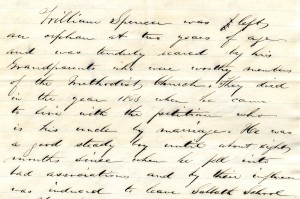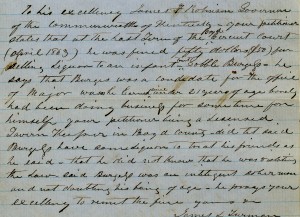By Matthew C. Hulbert
 In 1865, a jury of Covington (KY) residents slapped William Spencer with a 3 ½ year sentence for stealing a pair of pants from a fellow boarder. Now, if you’re at all familiar with previous CWG-K bloggings, you know that convicted murderers, rapists, and rampaging guerrillas frequently found themselves on the business end of far lighter sentences than Spencer (and sometimes without any sentences at all). What makes this case all the more compelling, however, is that by modern standards—that is, by contemporary, western ones—William Spencer was still a child at the time of his trial. According to affidavits, he was “left an orphan at two years of age and was tenderly reared by his Grandparents who were worthy members of the Methodist Church.” His grandparents died soon after and, while living with an uncle, young William fell in with “bad associations.” At roughly fifteen years of age, he quit “Sabbath School,” ran away from home, found a job, lost it, and was induced by poverty to steal the aforementioned pair of trousers.
In 1865, a jury of Covington (KY) residents slapped William Spencer with a 3 ½ year sentence for stealing a pair of pants from a fellow boarder. Now, if you’re at all familiar with previous CWG-K bloggings, you know that convicted murderers, rapists, and rampaging guerrillas frequently found themselves on the business end of far lighter sentences than Spencer (and sometimes without any sentences at all). What makes this case all the more compelling, however, is that by modern standards—that is, by contemporary, western ones—William Spencer was still a child at the time of his trial. According to affidavits, he was “left an orphan at two years of age and was tenderly reared by his Grandparents who were worthy members of the Methodist Church.” His grandparents died soon after and, while living with an uncle, young William fell in with “bad associations.” At roughly fifteen years of age, he quit “Sabbath School,” ran away from home, found a job, lost it, and was induced by poverty to steal the aforementioned pair of trousers.
At first take, sending a fifteen year old boy to the state penitentiary—a facility brimming with much older, more violent inmates—for stealing a pair of pants seems unthinkable. Even more so when we recall that the pants weren’t even new and couldn’t have been worth more than a few dollars. In reality, though, this wasn’t all that unusual of an occurrence in Civil War Kentucky. To put things mildly, perceptions of adolescence and understandings of how the law should be applied to children was a combined mess.
 Take for example the legal woes of James L. Turman, a tavern owner in Boyd County, who was fined $50 for “selling liquor to an infant.” The legal drinking age in Kentucky was twenty-one, then as now, and Turman fully confessed to having sold spirits to Sobble Burgess in spring 1863. The barkeeper defended himself, however, owing to the facts that at the time of the sale, Burgess was twenty years old and representing himself as twenty-one, but was also “well grown,” “doing business for himself,” and had permission from his father to drink. Perhaps most strikingly of all, in May 1863 when he bought the drink, Burgess was a candidate in Catlettsburg’s mayoral election, which Turman assumed could only be so if Burgess was “in his majority.”
Take for example the legal woes of James L. Turman, a tavern owner in Boyd County, who was fined $50 for “selling liquor to an infant.” The legal drinking age in Kentucky was twenty-one, then as now, and Turman fully confessed to having sold spirits to Sobble Burgess in spring 1863. The barkeeper defended himself, however, owing to the facts that at the time of the sale, Burgess was twenty years old and representing himself as twenty-one, but was also “well grown,” “doing business for himself,” and had permission from his father to drink. Perhaps most strikingly of all, in May 1863 when he bought the drink, Burgess was a candidate in Catlettsburg’s mayoral election, which Turman assumed could only be so if Burgess was “in his majority.”
Then we have the case of John Watson, a fourteen year old boy who enlisted in the Provost Guard as a drummer in 1861. A couple of years later, when part of his battalion was mustered out of service, Watson “reenlisted in Capt Flares Mounted company 34th Ky Vols.” This move prompted Colonel W. Y. Dillard of the 34th Kentucky Infantry to write Governor Thomas E. Bramlette with a request to have John transferred to his command; apparently the Colonel had “promised his [Watson’s] widowed mother to take care of him So long as I remain in the service.” In other words, with the Union not facing troop shortages like the Confederacy, Dillard understood that Watson was still a child and believed that he didn’t belong in combat service. (Once under his purview, Dillard could have Watson put back into his role as a drummer boy.)
Around the same time Dillard was trying to secure a transfer for Watson, a “free man of color” named Peter Yager was being convicted of larceny. According to petitioners on his behalf, Peter “was charged with stealing Tobacco, which was tied up in large hands & handled indifferently, and upon the trial, the proof introduced established beyond a doubt, that said Boy Peter, raised & cured just such Tobacco.” They also argued that “the Boy Peter proved a good character from his youth up to said trial, for industry and honesty his age was also proven to be from 15 to 17 years.” Translation: Peter’s (white) defenders believed that a farmer had carelessly lost his own tobacco and then blamed Peter for stealing it to cover the loss, despite proof that the young man had raised his own crop. Even the town marshal who’d originally arrested Peter and the prosecutor who’d convicted him signed the plea for executive clemency.
 Finally, we come to the October 1863 saga of Graham Akin, a fourteen year old boy from Danville. Described as “very delicate & slender,” Akin was swinging in the gymnasium of the Frankfort-based Waterman School when Thomas Davenport, three or four years Akin’s senior and billed as “heavy & stout,” stood in front of the swing and refused to move. Akin tried to ignore the bully; “he continued his exercises and slightly brushed against Davenport, where-upon Davenport Choaked and otherwise maltreated Akin.” In response, Akin snapped: he “rushed into the house of Mr Waterman, sized his gun and shot Davenport with small shot.” A grand jury in Frankfort indicted Akin on a charge of “shooting, in sudden heat and passion … with intent to kill.” Despite being held on $6000 bond, when Akin pled guilty to the charges, he was found guilty and fined just $50.
Finally, we come to the October 1863 saga of Graham Akin, a fourteen year old boy from Danville. Described as “very delicate & slender,” Akin was swinging in the gymnasium of the Frankfort-based Waterman School when Thomas Davenport, three or four years Akin’s senior and billed as “heavy & stout,” stood in front of the swing and refused to move. Akin tried to ignore the bully; “he continued his exercises and slightly brushed against Davenport, where-upon Davenport Choaked and otherwise maltreated Akin.” In response, Akin snapped: he “rushed into the house of Mr Waterman, sized his gun and shot Davenport with small shot.” A grand jury in Frankfort indicted Akin on a charge of “shooting, in sudden heat and passion … with intent to kill.” Despite being held on $6000 bond, when Akin pled guilty to the charges, he was found guilty and fined just $50.
So what happened to all of these “child criminals?” And more importantly, what sense can we make of their stories?
- In September 1863, John Turman had his fine remitted for selling liquor to a minor and, while it appears Sobble Burgess lost his bid for the mayor’s office, he was never legally disciplined for misleading Turman.
- In December 1863, William Spencer was pardoned after serving only about a month of his prison sentence; he went to live in New York with relatives and, as far as we can tell, stayed out of trouble.
- Unfortunately, we aren’t sure if John Watson was transferred to the care of Colonel Dillard—or if he survived the war.
- We do know, however, that freeman Peter Yager had served half of his prison term by the time his petition was rejected by Governor Thomas Bramlette and that he spent another six months in the state penitentiary. (This isn’t a major surprise: by 1863–64, Governor Bramlette did little to hide contempt for his African American constituents.)
- And, lastly, there’s Graham Akin, who pleaded guilty to attempted murder and was fined a whopping $50. Upon appeal to Governor Bramlette, his fine was remitted. Davenport, now sporting a nasty scar, presumably stopped picking on Akin.
As their cases collectively illustrate, from regulations on drinking and firearms to military service and everyday criminal offences, the law in Kentucky generally failed to take a consistent stance on children. On one hand, the state enforced a mandatory drinking age, which clearly transmitted the idea that some citizens (those under twenty one) were not yet considered “legal adults” by the law’s reckoning. But the state also allowed boys technically under the legal enlistment age to serve in the military, which immediately weakens the notion that mandatory age limits were strictly enforced across the board and calls into question how the state could justify not allowing a twenty year old citizen to drink whiskey on account of his age but saw no issue with handing him a rifle and sending him into Napoleonic combat. (A question many still ask of current drinking and enlistment laws in the United States.)
On the other hand, though, we see numerous instances of children either being punished as adults for petty crimes, such as stealing worthless pants, or being pardoned due to their youth and inexperience for very serious crimes, such as attempted murder. This indicates that to some extent, the legal code in Kentucky blanketed all of the state’s residents, regardless of age, with a “universal adulthood”—while at the very same time the people who supposedly made and maintained that legal code (the governor, judges, lawyers, town marshals, etc.) understood more often than not that children ought to have been afforded unique treatment by the justice system.
Why they didn’t take the time to update the books and infuse stability into the juvenile sector of the justice system is anyone’s guess, though being trapped in the middle of the bloodiest military conflict in American history probably had something to do with it. Regardless, Kentucky was the epitome of contradiction when it came to legally dealing with children in the 1860s. Then again, given the state’s penchant for Conservative Unionism, its self-injuring methods for combating irregular violence, and the peculiar, even counter-intuitive legal hoops it jumped through to protect slavery, when wasn’t Kentucky a contradiction during the Civil War?
Matthew C. Hulbert is an Assistant Editor of the Civil War Governors of Kentucky Digital Documentary Edition.
SOURCES: Richard Areson, Affidavit, n. d., Kentucky Department for Libraries and Archives, Frankfort, Kentucky (hereafter KDLA); Richard Areson to Thomas E. Bramlette, 24 Nov 1865, KDLA; James L. Furman to James F. Robinson, 4 May 1863, KDLA; Charles B. Cotton to Thomas E. Bramlette, 6 Jan 1864, KDLA; P. U. Major, W. H. Sneed, and John M. Hewitt, Jr. to Thomas E. Bramlette, 23 Oct 1863, KDLA; S. D. Delaney et al. to Thomas E. Bramlette, n. d., KDLA; H. M. Pierce to Beriah Magoffin, 28 May 1861, KDLA; W. Y. Dillard to Thomas E. Bramlette, 9 March 1864, KDLA; W. L. Jermane to Thomas E. Bramlette, 28 Nov 1865; KDLA.
